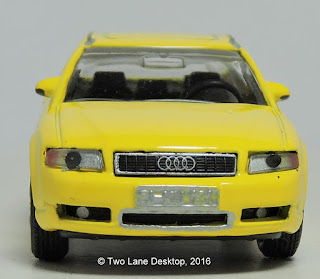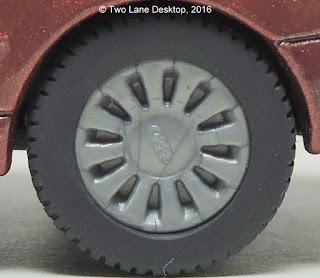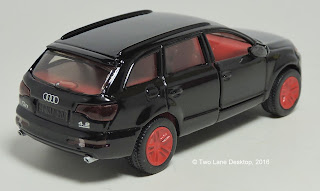Siku Audi and Volkswagen sedans and wagons
Siku is another diecast maker that is centered in a country’s origins when
it comes to making models. Like Tomica
with Japan Siku mostly refers to Europe with an occasional trip to America and
Japan, and like Tomica you can see a faithful ancestory with certain models and
brands. A good example is the range of
sedans and station wagons from Volkswagen and parent Audi companies. Here’s a look at the good stuff that also
includes one SUV.
Audi 200 5T and 100 Avant
Siku started with two Audi-sourced models, the Audi sedan and VW Passat
Variant wagon in the 1970’s. Since then
the models have stayed consistent with more focus in the Audi brand as you’ll
see shortly. One of the best is the Audi
brand and it shows with this 200 sedan and 100 Avant wagons that were both
introduced in the 1980’s. Audi was
making big in this decade with the rally-winning Quattro now migrating to other
Audi models and giving a name to the brand, as it the focus on higher-end
luxury to distant itself from Volkswagen, but at the cost of unattended
acceleration issue that nearly ended the life of Audi. The 200 5T is the top-model of the 100 line
that features more luxury content and a sporty ride thanks to a 2.1L SOHC I-5
that produces 168 horsepower through a 5-speed manual transmission. The 100 also gained the Avant wagon and more
aerodynamic styling that gave the 100 a more modern look. The Avant has a more fastback rear roofline
with rear spoiler attached to the rear window.
The interior is spacious with seating for five and a caverous caro
area. Both 100 and 200 have Euro-like
interiors with well laid-out controls and 4-spoke steering wheels. The 200 is based on the previous-generation
100 as it lacks the new aero styling.
The Avant powertrain is the same as the 200 with turbocharging and a few
more horsepower.
This green 200 5T sedan is a big one as is the case with a few other Siku
models from the 1980’s. The front has
detailed quad square headlights that are part of the metal base, black grille
with Audi rings, headlight washer nozzles on the front bumper, and a lower chin
spoiler. The sides show off a typical
sedan look where I added black trim to liven it up and common multi-spoke Siku
wheels that look great on this car. At
the rear is a conventional look with trunk and rectangular taillights that are
part of the red interior. The interior
has detailed seats for five people, shifter on the console, and a white dashboard,
though much of the footwell is taken over by the door hinges for the opening
doors and without a spring retractor tend to ajar too easily. The metal base contains the usual Siku
technical specifications. The Audi wagon
looks very sleek in red with a low stance, sloping roofline, and Siku wheels
that finish off the sporty look. The
front has flush headlights that are part of the window trim, metal grille with
Audi rings that connect to the front bumper, both part of the metal base. The sides show lots of side windows, a
sloping D-pillar with rear spoiler on the rear hatch, and adding black trim
gives the 100 Avant a finished look. The
rear has square taillights, a metal bumper, and an opening rear hatch that opens
to nearly a 90 degree stop thanks to large hinges that are visible in the large
cargo area. The interior has seating for
five with plenty of room, though the white dashboard lacks full detail and
should as it has no door hinges to obstruct it.
The real car’s dashboard has a more modern look with a few more switches
and controls over the 200 5T’s simple layout.
1993 and 2007 Volkswagen Passat Variant’s
For the Passat line it has been nothing but wagons for the mid-size sedan
ever since the beginning. Here is two different
generations of Passat wagon’s over two generations (The middle one can be found
as a Welly 1:64 2001 model). The 1993
version goes for a clean and boxy look with some Audi influence in the design,
especially inside where the dashboard layout shares the same Audi setup but
uses a less premium look to match the VW price point. The engine is a remarkable engineering defeat
as it uses a V6 motor, or more like a VR6: this is a narrow angle Vee motor
where the banks of cylinders are only 15 degrees apart. This allows the V6 to fit in even the smaller
Golf platform as it shares the same size as a typical I-4 block. The VR6 produces 140 horsepower through a
5-speed manual to the front wheels. This
setup also eliminates the longitudional layout of the old I-5 to take weight
off the front even though Audi still uses this setup today. Two decades later the 2007 Passat Variant
still has the same setup, though styling now looks more premium and shared with
the Touareg and Golf V models and that includes the large grille design also
found on Audi models. At this time VW
was looking to go upmarket so it was not common to see high-end materials in
the nicely-done dashboard. The engine is
a new 2.0L turbocharged I-4 diesel that produces 138 horsepower through a
six-speed automatic transmission. This
was the last-generation to share Passat models in the U.S. with the rest of the
world as the 2012 Passat got its own model in the U.S.
The 1993 Passat Variant is part of the new Siku in the 1990’s that used
plastic bases and a new wheel style that looked more like the hubcaps found on
Mercedes-Benz cars at the time. The dark
blue wagon looks really good with white square headlights up front, VW badge, and
lower black bumper with signal and foglights.
The sides show off a boxy wagon profile with roof rails, while the rear
has square taillights like the Audi Avants and an opening rear hatch to expose
the cargo area. The chassis underneath
now has more details to show off the front engine and drivetrain, the
suspension, exhaust system, and even the spare tire well. The interior has seating for five in white
with good details and a center console with shifter, but the dashboard is still
a flat blank space with steering wheel.
Hopefully in the 2000’s the new Siku plan with rubber tires and better
detailing would improve the Passat, but in fact the opposite happened. The white 2007 model looks good in red and
sports 5-spoke wheels that could use some chrome and rubber tires. The casting is huge and almost SUV like (for
example, the Q7 in this review is the same size as this Passat Wagon!) with a
thicker beltline and some trim areas that seem crude. The front end has a large VW grille with VW
logo and silver bumper center, projector headlights to the sides, and on the
bumper is the signal lights and foglights.
The rear has a rear spoiler, taillights with round LED brake lights, and
a nice plate integration into the hatch along with VW badging. Instead of an opening rear hatch the doors open
to show off the five-seat interior with a proper dashboard layout design
(yaay!) and 4-spoke steering wheel that seems to be tilted too far upward. If the large and crude exterior dimensions
were not enough the performance was not anything to smile about either as the
VR6 Passat seems more fun than this one even if the newer Passat has all-wheel
drive. I like the older VR6 Passat as I think
the newer Passat Variant is too crude-looking and really off in size.
The Audi A4 family
Audi and VW Wagons are not the only thing that Siku has made in
generations, take a look at the A4 model line with three different models, two
of them Avants, and all are very nicely done.
The A4 was the successor to the 80 series as the smaller Audi model line
and introduced in 1994 gained fame for styling that was not only smooth, but
sporty at the same time. This styling
would evolve in other Audi models and start to give Audi a new lease on life as
the leader of performance and style after the ill-fated recalls. The second-generation was an evolutionary
design with some influence from the 1997 A6 sedan and also included the first
new Audi convertible based on the A4 platform.
The powertrain in this Avant wagon in yellow is a 2.5L turbodiesel I-4
that produces 161 horsepower through a 5-speed manual transmission through the
quattro all-wheel drive system. The
dashboard layout is clean and simple and would be a hallmark to Audi that
others would try to copy. By the
next-generation the styling would evolutionize again now with the new large
Audi grille up front. The Convertible
was a big improvement over the old 80-series cabriolet that lasted until 2000
and featured seating for four with a soft top that tucks in nicely under a hard
tonneau cover. The engine is a 3.2L DOHC
V6 that produces 252 horsepower through a six-speed automatic transmission and
quattro all-wheel drive.
The next-generation finally went for a new look that used a more edgier
look shared with the new A5 coupe, and the A4 cabrio now becomes the A5
cabrio. The rear carried the same look
as the previous-generation, but with a lower roofline for a more sporty
appearance. The interior has a
redesigned dashboard to fit the new Audi multilink infortainment screen. The engine is a 3.0L DOHC turbodiesel V6 that
produces 237 horsepower through a 6-speed manual transmission, all of which now
sits on a new platform that tucks the front powertrain further back for better
front weight distribution.
Both Avant wagons look very sharp and sporty, with the 2001 version adorned
in yellow and has a more traditional wagon roofline. The front has horizontal projector headlights
with black center grille with Audi rings and a lower bumper with scoops,
foglights, and an Euro plate. The rear
has vertical taillights, a rounded rear hatch, and a trailer hitch. The base shows off the dual exhaust and spec
information, while the interior with opening front doors shows the best of Siku
models with a proper dashboard design, detailed controls, 4-spoke steering
wheel, center console with shifter, and seating for five. Oh, and those 5-spoke wheels have rubber
tires. A great model, until you see the
newer 2008 Avant in dark green with tan interior sporting thinner 5-spoke
wheels with lower profile tires. The
front has square headlights that peer forward to go with the extended Audi
grille in black, while the lower side scoops add foglights. The roofline is more sporty with a drop in
the roof that occurs between the c- and d-pillars and ends at the rear with
horizontal taillights, Euro plate on the hatch, and dual exhaust below the
bumper.
The chassis has a similar setup to the yellow A4 Avant with an interior,
accessed by opening doors, just as equally impressive with details with a deeper
steering wheel and higher dash top to accept the new info screen. The A4 Cabrio is a nice evolution of the
80-series Cabriolet that Siku has made in the 1990’s, and the new one benefits
from better detailing and new Audi-style multi-spoke wheels with rubber tires,
though the tires are a bit too thick for this car. The front has slightly offset projector
headlights with lower scoops and foglights and a large black Audi grille with
Euro plate. The metallic red color sets
off with the gray interior and windshield with silver frame surround and
exterior mirrors on the doors, while the rear has square taillights, Audi
badging, and dual exhaust on the rather highly-raked rear end. No opening parts? No problem as the open top
environment shows off the excellent interior detailing that starts with seating
for four with detailed side bolsters, detailed door panels, large 4-spoke
steering wheel, and dashboard with proper control layout and shifter on the
center console. The A4 family has been
one of the finely-detailed Siku models in the range as these three generations
show.
1997 Audi A6 sedan and 2005 Audi Q7 SUV
These last two are add-ons and show how much the advancements at Audi and
the world have changed the brand over time.
The second-generation of the A6 added styling influenced by the Bauhaus
and created a round, fastback rear look that would be shared with a few other
Audi models. The interior was clean and
simple with higher-quality materials to take on the Mercedes E-class and BMW
5-series. This is the generation where
the S and RS models make their appearance as well was the Allroad wagon. The powertrain is a 1.9L DOHC turbodiesel I-4
that produces 110 horsepower through a 5-speed manual transmission. The Q7 SUV was based on the Pikes Peak
concept and would be Audi’s first SUV sharing a platform with the VW Touareg
and Porsche Cayenne. The styling is
sleek with familiar Audi clues and a long, sweeping back roofline that still
offers seating for seven inside. The
dashboard layout was familiar Audi with modern touches that would be seen down
the line in future Audi models. The
powertrain is a 4.2L DOHC V8 that produces 350 horsepower through a six-speed
automatic transmission through the quattro all-wheel drive system.
The A6 sedan seems to be a bit crude thanks to large door gaps and those
hubcap wheel s that make the car look low-end.
The front has silver headlights that wrap around the front, black Audi
grille, and a lower grille with foglights that span the ends. The sides show a more smoother look with
flared fenders around the wheels and lots of window greenhouse, while the rear
has taillights that wrap around the corners, Audi badges, and Euro license
plate. The base shows off the exhaust,
front drivetrain, and usual Siku specs, while the interior has seating for
four, opening front doors, shifter, 4-spoke steering wheel, and a dashboard
that is set rather far back than usual.
The Q7 was an extra car as it was sent first before the correct car was
sent later on, so at first I’m not too set on the red 5-spoke wheels with
rubber tires, but after a while the red and black look good on this SUV. The
front has horizontal headlights that flow back from the large front grille with
Audi rings, while signal and running lights sit lower on the bumper just ahead
of the side scoops and the foglights at the bottom end of the bumper. The sides show a sleek SUV roofline with
door-mounted mirrors on doors that do open, while the rear has horizontal
taillights that are part of the rear hatch, Euro plate, and dual exhausts with
reverse and signal lamps on the bumper.
The interior only shows seating for five, but it is nicely done with
detailed center console, shifter, center stack controls, and 4-spoke steering
wheel, though the upper portion of the dash seems to be set too far forward.
This is just some of the many Audi and VW models that Siku has made over
the years, yet sedans, wagons, and now SUV’s are the most common part of these
duo brands.


















































































































































Comments
Post a Comment